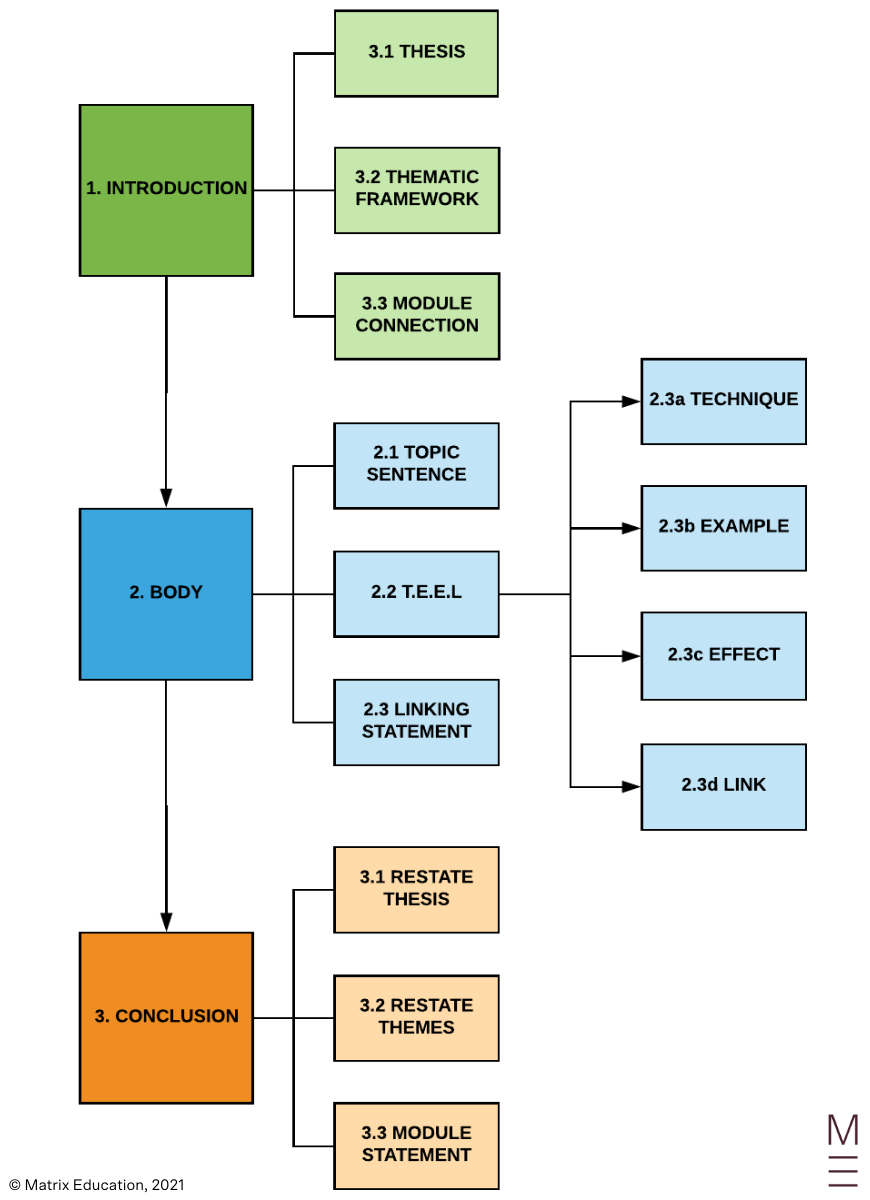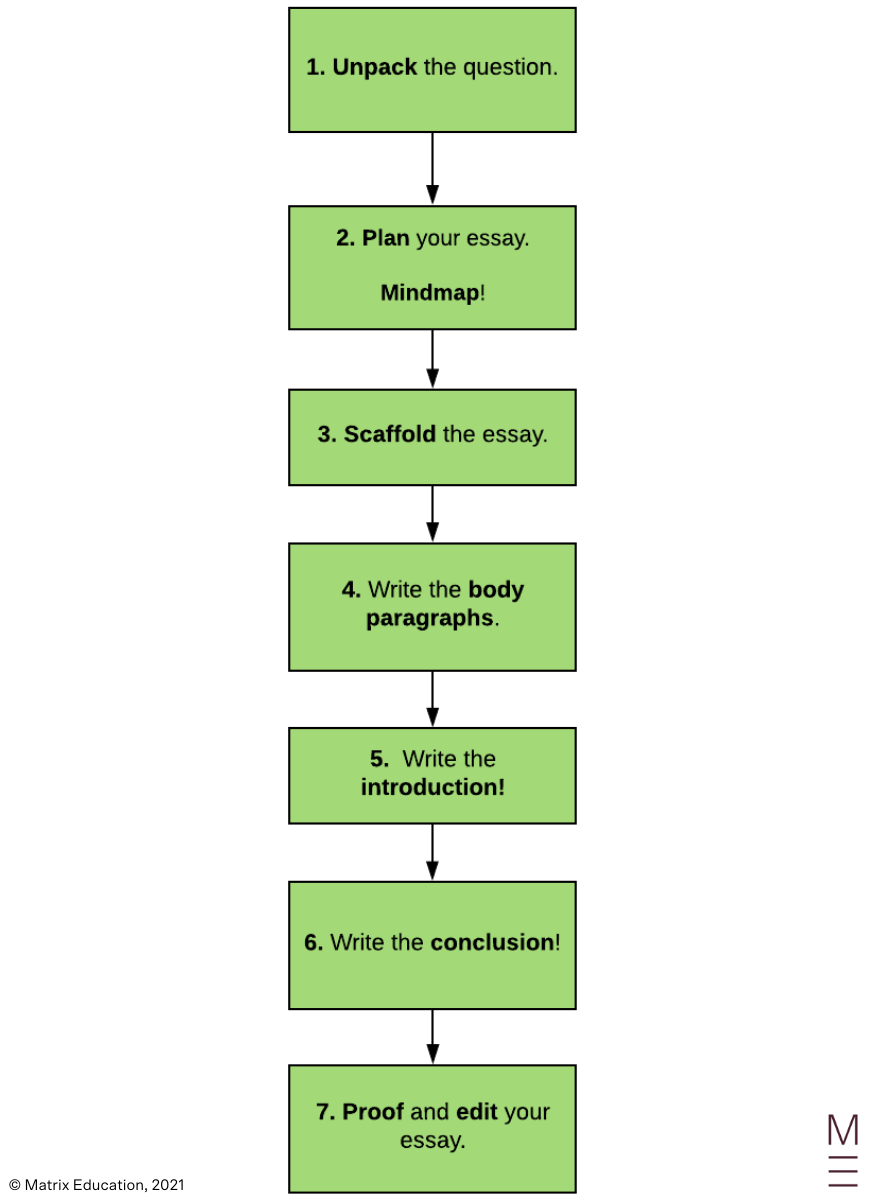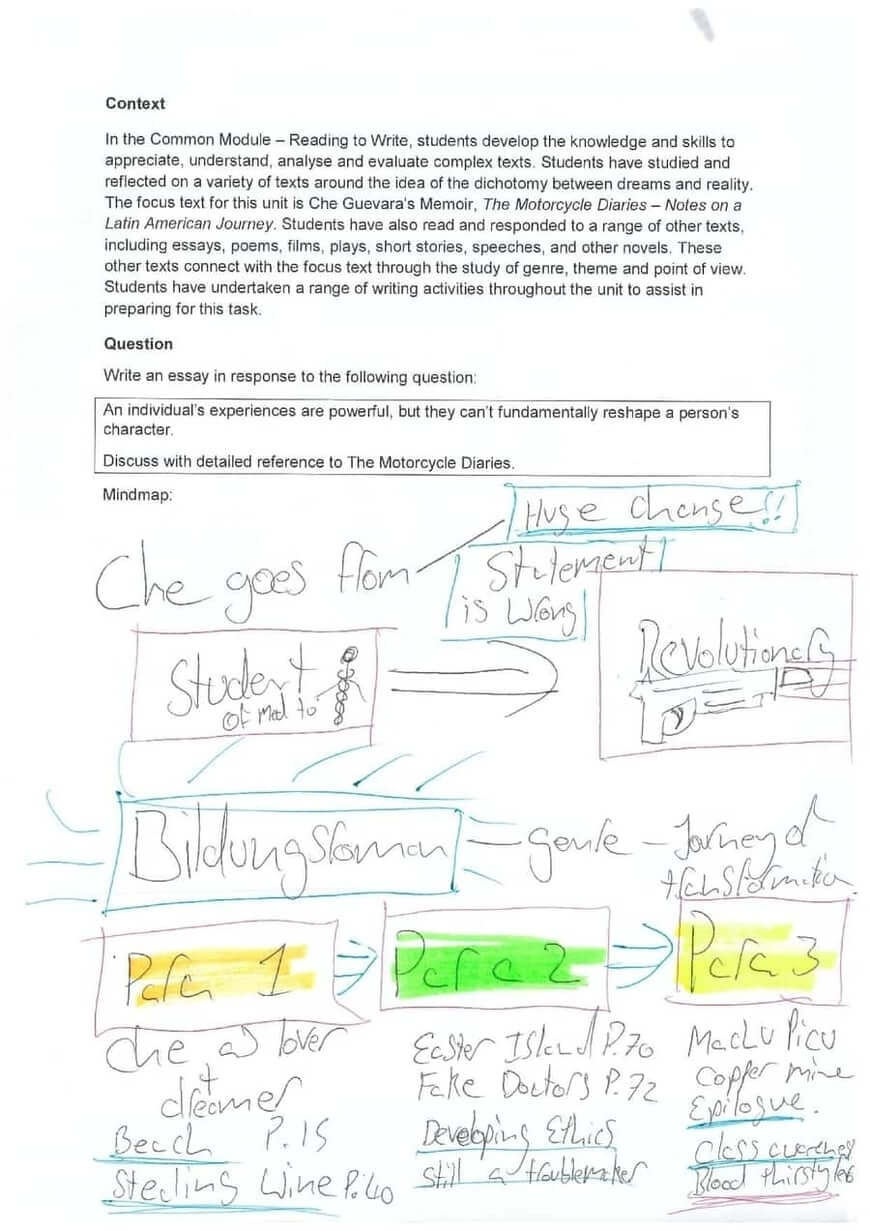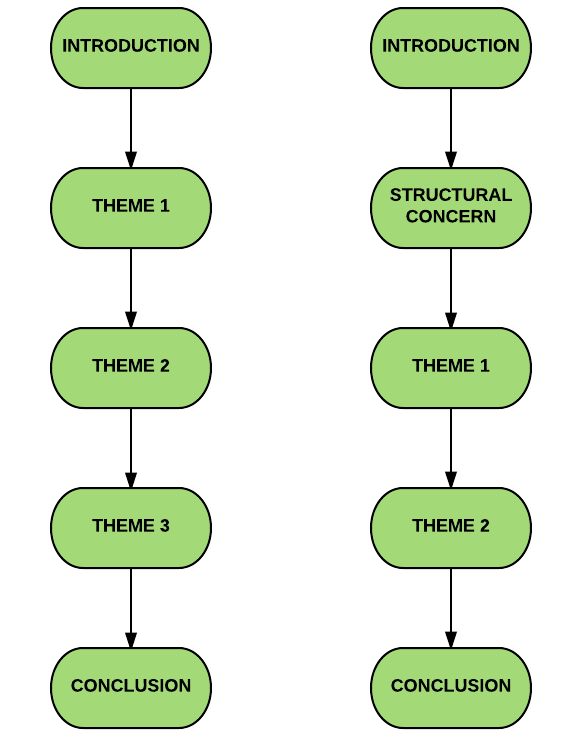Welcome to Matrix Education
To ensure we are showing you the most relevant content, please select your location below.
Select a year to see courses
Learn online or on-campus during the term or school holidays
Learn online or on-campus during the term or school holidays
Learn online or on-campus during the term or school holidays
Learn online or on-campus during the term or school holidays
Learn online or on-campus during the term or school holidays
Learn online or on-campus during the term or school holidays
Learn online or on-campus during the term or school holidays
Get HSC Trial exam ready in just a week
Get HSC exam ready in just a week
Select a year to see available courses
Science guides to help you get ahead
Science guides to help you get ahead

Guide Chapters
Do you struggle to get started when writing essays? Are you ensure of how to structure an essay? In this article, we’ll show you how to plan and structure an essay so you give markers what they want.
In Part 5 of our Beginner’s Guide to Acing HSC English, we’ll give you a step-by-step process for producing those strong essay responses you’ve been struggling to write. Knowing how to write an essay is one of the most important skills you will need to master as an English Student. In this section, we focus on how to plan and structure an essay.
Get 24/7 help for HSC Trial Prep
Get instant support with Ask Max your AI study buddy, included in your HSC Trial Prep course.
Essays are a means for individuals to convey detailed ideas to others. Essays usually convey a particular perspective on the issue or idea being discussed. Because of how human beings process information, we tend to apply universal conventions and structures to essays – as we do to speeches – so that our audience can understand and retain the ideas and arguments they contain.
Essays can sometimes feel like vague tasks. Comments like “you haven’t answered the question” can be demoralising.
By far the most common issue in essays is using evidence effectively. They list rather than developing an argument!
Students struggle because:
Before you begin to write your essay, you need to complete the following checklist:
But how do you do that? You should read Part 2 of this Guide: How to read and Analyse Texts if you are unsure.

Level up how you analyse texts and take notes with expert strategies and templates!

Fill out your details below to get this resource emailed to you.
"*" indicates required fields
Once you’ve done your prep, you need to know how to write an essay to refine your ideas. But how do you actually do that? Before we show you how to write an essay you need to know how it should work and what its different parts are.
There are three main parts to an essay:
The flowchart below illustrates the different components that are necessary for a Band 6 Essay:

Now you have visualised this structure, let’s discuss the various parts involved:
1. Introduction – Outlines your argument.
It has 2 parts:
2. Body – A series of paragraphs that substantiate the argument presented in the introduction.
It has three important parts:
3. Conclusion – A summary of your argument.
You need to be succinct yet comprehensive when concluding your essay. To do this, you need these three parts:
It helps readers follow your argument. When you employ an essay structure that uses a thesis statement, topic sentences, linking statements, and a conclusion you guide the reader through your argument. This is a very important thing to do as it allows them to follow along with your ideas and thought processes. This is a process of using signposting and framing. So let’s see what that entails and how it works:
Essays and speeches require you to introduce your ideas/themes so the audience knows what things are going to be discussed in your arguments.
Your introductions and conclusions are framing devices. Foreshadowing your argument with an introduction and reminding the reader of your ideas with your conclusion provides readers with a clear understanding of what you have argued.
Topic sentences are signposts that work in conjunction with introductions and conclusions to guide a reader through your argument. They say to the reader, “Remember that idea from the introduction? We’re going to discuss it in detail in this paragraph.” The other signposting device is the linking statement at the end of the body paragraph. This will connect your argument back to the rest of the essay and make the connection clear to your reader.
Repetition
Repetition helps convince an audience of your position. As humans, we don’t retain as much information as we think we do. Repeating ideas, and reinforcing how your examples relate to your overall thesis, will help your audience follow your argument and retain key ideas like those stated in your topic sentences and theses.
Evidence
We use evidence to support our points. Audiences are sceptical, evidence allows us to give a practical demonstration of why our argument is correct. This will support our point and reinforce our key ideas and theses. Matrix English students learn how to use T.E.E.L structures to produce insightful essays.
Summaries
Summaries remind audiences of the arguments they’ve been exposed to. Thus, your conclusion helps them retain the key ideas and convince them of your position.
Now you understand how essays and signposting work, it’s time to take you through the step-by-step process for writing an essay to ace English like Matrix students do.
An essay needs to take all of a student’s ideas and study notes and translate them into a logical and well-structured response that shows the reader your understanding and perspective of the text. There’s a step-by-step process for doing this effectively, let’s have a look at it. Below is the process for writing an essay at home or in class:

Prep for English HSC Trials in just one week
Write top responses with expert feedback and mock exams. Maximise your HSC Trial revision with the experts.
You can see that this process is different to what you need to do in an exam. In an exam time constraints mean that you must begin with the introduction and work forwards to your conclusion. However, when you are developing your ideas, writing practice essays, or producing a longer essay as an assignment, you will plan your introduction and refine your body paragraphs before crafting the perfect introduction for your argument. In light of this difference, we will address exam essay technique after this step-by-step process.
Planning an essay is a step-by-step process. Students need to think things through before they put pen to paper. Having thorough study notes is crucial to this. Let’s consider what this process involves:
Once you’ve done the unpacking, you are ready to plan things fully. Use this as an opportunity to brainstorm and choose relevant examples, you must also think about the structure you will use for your response.

Now that we’re ready to write, let’s look at how to write the essay.
Now you’ve planned everything in terms of ideas and examples, you must make a decision about what process you will follow to write your essay – do you begin with body paragraphs or the introduction? Then you need to decide on your essay scaffold. Let’s start by considering your approach.
Strategies for writing a practice essay
There are two different ways to go about producing a practice essay or take-home assessment. Begin with the body paragraphs or write from introduction through to conclusion. You will probably find it easier to begin with body paragraphs when you are developing your ideas and analysis and practising your writing.
When you are more confident, you may start writing from introduction through to conclusion. This is something you must practise if you want to be prepared for essays in exams.
What are these strategies:
Strategy 1: Begin with body paragraphs and topic sentences
Some students find it easier to flesh out the arguments around specific ideas first. This is a useful method for students who aren’t sure of how their ideas might fit together, or who struggle writing conclusions. This method requires students to:
Strategy 2: Start from the introduction and write through to the conclusion
Some students are able to write from an introduction and develop their ideas directly into body paragraphs. This is a skill all students need to have for exams. But not everybody can produce their first drafts this way.
Often, students need to develop their individual ideas to see how they fit together.
The first method is fine for writing practice essays or “take-home” assessments. But in exams, you should only use the second method (you don’t want to run out of time without an introduction or a conclusion).
As this is a practise essay, we’ll begin with the body paragraphs. We’ll discuss exam essays after we’ve worked through this step-by-step process. But first, before we continue with Step 3, we need to understand what an essay scaffold is and the differences between integrated and divided structure are.
Let’s have a quick look.
When you plan an essay, you must think about how you will scaffold it. Let’s look at some of the options you have.
An important consideration for writing essays is the scaffold. When we talk about scaffolds, we mean the order in which themes or texts are discussed in an essay. Different Modules will require different approaches. A Module that requires you to compare multiple texts will need a type of scaffold that allows you to efficiently contrast and compare ideas rather than just the texts.
Let’s look at the difference between integrated and divided paragraphs.
One of the important questions students will need to answer is:
Do I write a divided or integrated response?
The two common scaffolds for the HSC are integrated or divided:
Integrated paragraphs
Integrated paragraphs discuss multiple texts around one theme in a paragraph.
Divided paragraphs
Divided paragraphs discuss one text and at least one theme in a paragraph.
Neither scaffold is “better” than the other, they both work and in the HSC, markers must treat both the same. You will not lose marks for using an integrated response or a divided response. You will only be marked on how well you use the scaffold. Matrix English students get detailed qualitative feedback that will help them choose the right scaffold for their assessments. Getting the scaffold right for your abilities and the content you are producing is important.
Below are a couple of single text scaffolds you might use:

Below are some different comparative essay scaffolds that you can use to structure your essays:
Once you have decided which scaffold will best suit your response, you are ready to start composing the body paragraphs.
In the next part of this article, we’ll step you through the writing process. We’ll give you step-by-step processes for writing your body paragraphs and then developing killer introductions and conclusions.
While scaffolding drills aren’t the same as writing practice essays, they are an excellent way to develop confidence for unpacking questions and structuring answers!
You should aim complete scaffold drills throughout the term. Ideally, you should be doing them at least once a week, and slowly ramping up when you are nearing your exam period. So, what are they?
To do a scaffold drill, to a 10 minute timer you must:
As you can see, this a challenging amount to get done in a small amount of time – an introduction and essay plan! But this is a great way to simulate exam conditions and help you get used to thriving under exam pressure!
We have a detailed article, here, that will help you understand the process in a practical and detailed manner. Alternatively, you can watch our video where we talk you through it and discuss a worked example from Year 12 Common Module!
This is the final push before the HSC and your textual analysis needs to be perfect! Get expert help developing it and your writing skills with our Year 12 English Advanced Matrix Course. Learn more.
Create Band 6 essays and insightful analysis
Expert teachers. Band 6 resources. Proven results. Boost your marks these. Limited spots available!
© Matrix Education and www.matrix.edu.au, 2025. Unauthorised use and/or duplication of this material without express and written permission from this site’s author and/or owner is strictly prohibited. Excerpts and links may be used, provided that full and clear credit is given to Matrix Education and www.matrix.edu.au with appropriate and specific direction to the original content.